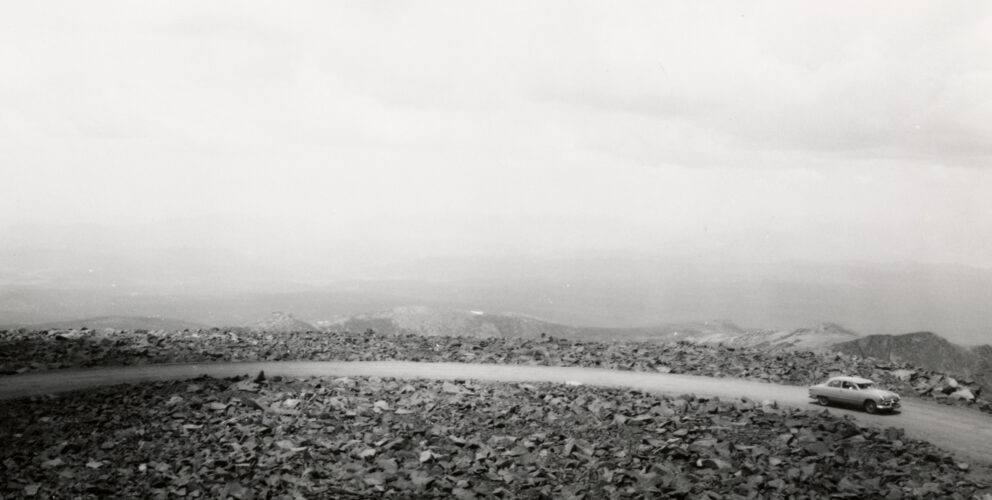Along the Mississippi, 1926; © E.O. Hoppé Estate Collection / Curatorial Inc.
In 1926, the famed British photographer E.O. Hoppé spent six months on the road, touring the United States in preparation for the book Romantic America, which published in 1927. At its release, it was the most comprehensive and lavishly illustrated travel book focusing on the country. Sixty images from this project are on view in In Search of America: Photography and the Road Trip through October 19 in Gallery 235 and Sidney S. and Sadie M. Cohen Gallery 234.
Hoppé’s was an epic trip, taking in all four corners of the country and 130 cities in between. He was in St. Louis at the start of the third week of his trip, having just spent time farther north in Chicago and the sand dunes of Michigan.

From the Museum, 1926; © E.O. Hoppé Estate Collection / Curatorial Inc.

St. Louis Zoo, 1926; © E.O. Hoppé Estate Collection / Curatorial Inc.
In his one day in the city, Hoppé covered a remarkable amount of territory. To the west, he visited and photographed Washington University’s campus, displays at the Saint Louis Zoo (including a bear who seemed quite willing to pose), and the statue—the Apotheosis of St. Louis—in front of the City Art Museum (now the Saint Louis Art Museum).
To the east, he photographed the Midtown Plaza, at 13th and Locust Streets, with its sunken garden and fountain. The picturesque square was surrounded by a variety of building types, which no doubt captured Hoppé’s interest: an Art Deco skyscraper on the left housing the headquarters of the Shell Oil Company, the neo-Gothic Christ Church, and the just-completed 26-story Southwestern Bell building in the near distance.

A City Square in St. Louis, 1926; © E.O. Hoppé Estate Collection / Curatorial Inc.
Hoppé spent the largest amount of time near the riverfront, which was both historically important to the city and a nexus of various modes of transportation. His image of the Old Courthouse showed the building in a state of some disrepair as it was nearing the end of its life as an active court of law. He was particularly fascinated by the forms of the steel bridges crossing the Mississippi River, which allowed the country to be interconnected.
Hoppé had already spent considerable time photographing the Brooklyn and Delaware Bridges on the East Coast; in St. Louis, he was anxious to visit the Eads Bridge—notable as the world’s first steel-truss bridge (completed in 1874). Hoppé was frustrated that he could not capture much detail of the structure because he was there on a particularly humid summer day. Ever inventive, he instead incorporated the lattice of a girder—used to support elevated trains—across the picture top; its unusual graphic impact served to emphasize the bridge’s modernity. He contrasted the bridge with a paddle steamer, which served as a nostalgic tourist attraction.

Modern Bridge and Ancient Steamer at Dock, 1926; © E.O. Hoppé Estate Collection / Curatorial Inc.
Unfortunately, Hoppé’s enjoyment of the city was dampened by the hot and humid weather. Its effects were exacerbated by the fact that he was wearing a suit—since he thought that was proper—and he had to carry all of his camera equipment. Coming from London, he perhaps had little idea how hot it could be here. In his travel diary, he commented on the conditions in such detail that it evokes familiar discomfort to this day:
6am. At this early hour it is already hot. A dense white mist makes the heat more oppressive. It is wrapped around the city like a steaming wet towel. I am anxious to make pictures of the Mississippi but the mist blocks out all detail . . . you will allow all this was bad enough but it was not the worst! It was fourth of July—an incessant display of fireworks went on in the streets. The noise was hellish . . . The heat increased hourly. There was no shade on whichever side of the street one walked. From early morning until the late afternoon I saw not one man who wore a coat or collar—mine resembled collapsed jelly.
Well, St. Louis hasn’t changed, just the quality of our air conditioning. But this points to the physical exertion that was required by Hoppé to undertake such a project.
Hoppé also photographed looking south down the waterfront to some of the commercial activities of the ships unloading cargo. The MacArthur Bridge is documented in the middle ground, spanning the river. It was completed in 1917 with decks for both automobiles and trains and notably used as part of Route 66 from 1929 to 1955. Of all the areas that Hoppé photographed, this is perhaps the most changed today—even the trusses of the bridge have been replaced to safely accommodate modern train traffic.

Along the Mississippi, 1926; © E.O. Hoppé Estate Collection / Curatorial Inc.
Hoppé’s Romantic America was printed in Germany in the fall of 1927, with 304 images, including three from St. Louis. A reviewer at the St. Louis Post-Dispatch wrote glowingly: “A more beautiful volume than the one listed seldom finds its way to a reviewer’s desk. . . . No other single volume that this writer has seen gives so comprehensive and convincing a conception of our country’s greatness as does this tale told by a camera.”

